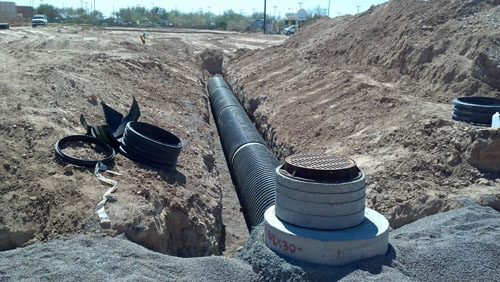Private sewer
A pipe carrying sewage (waste water and excrement) that serves only one property is referred to as a drain. Drains are privately owned and maintained as far as the boundary of the property. Beyond the boundary of the property a drain is referred to as a public lateral drain.
A pipe that serves more than one property is referred to as a sewer. Sewers that connect to the public sewer network are referred to as public sewers.
Under the Public Health Act 1936 all sewers (as defined by the Public Health Act 1875) which were in existence on 1 October 1937 became public sewers. After 1937 new sewers were only public if they were laid or adopted by the sewerage undertaker.
However, on 1 October 2011 in England and Wales, private sewers and lateral drains that were connected to the public sewer before 1 July 2011 were transferred to the ownership of the regulated sewerage companies (generally water companies).
This means that property owners only remain responsible for drains that serve only their own property, up to the point they connect to another drain or sewer, or as far as the boundary of their property. In the case of blocks of flats, the property owner(s) are responsible for the drain as far as the boundary of the property.
Properties not connected to the public sewer network, for example if they have a septic tank or cesspit, are not affected by this change, and their sewers or drains remain private. In addition, large commercial sites with multiple occupants may have private sewers or drains, as may sites in which sewers or drains discharge to a watercourse. Sewers owned by Railway Authorities also remain private.
New or existing sewers or lateral drains can be adopted by a sewerage company under Section 102 of the Water Industry Act 1991 (existing sewers) or section 104 of the Water Industry Act 1991 (new sewers). The sewerage company will then maintain them at their own expense.
Successful ‘adoption’ of sewers requires that they are constructed to required standards. If they are not, it may then be necessary to carry out remedial works to bring them up to an adoptable standard.
For more information see:
[edit] Related articles on Designing Buildings Wiki
- Cesspool.
- Difference between drains and sewers.
- Drainage.
- Drains.
- Grease management.
- Lateral drain.
- Manhole.
- Manhole cover.
- Public Health Act 1875.
- Public sewer.
- Safe working in drains and sewers.
- Sanitary pipework.
- Section 102 existing sewer adoption.
- Section 104 new sewer adoption.
- Septic tank.
- Sewer construction.
- Sewerage.
- Sewerage company.
- Sustainable urban drainage systems SUDS.
- Thames Tideway Tunnel.
- Waste water.
Featured articles and news
Moisture, fire safety and emerging trends in living walls
How wet is your wall?
Current policy explained and newly published consultation by the UK and Welsh Governments.
British architecture 1919–39. Book review.
Conservation of listed prefabs in Moseley.
Energy industry calls for urgent reform.
Heritage staff wellbeing at work survey.
A five minute introduction.
50th Golden anniversary ECA Edmundson apprentice award
Showcasing the very best electrotechnical and engineering services for half a century.
Welsh government consults on HRBs and reg changes
Seeking feedback on a new regulatory regime and a broad range of issues.
CIOB Client Guide (2nd edition) March 2025
Free download covering statutory dutyholder roles under the Building Safety Act and much more.
AI and automation in 3D modelling and spatial design
Can almost half of design development tasks be automated?
Minister quizzed, as responsibility transfers to MHCLG and BSR publishes new building control guidance.
UK environmental regulations reform 2025
Amid wider new approaches to ensure regulators and regulation support growth.
The maintenance challenge of tenements.
BSRIA Statutory Compliance Inspection Checklist
BG80/2025 now significantly updated to include requirements related to important changes in legislation.
Shortlist for the 2025 Roofscape Design Awards
Talent and innovation showcase announcement from the trussed rafter industry.























